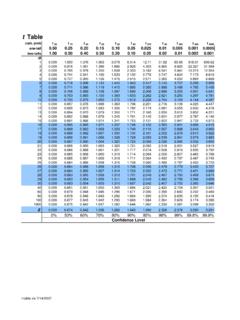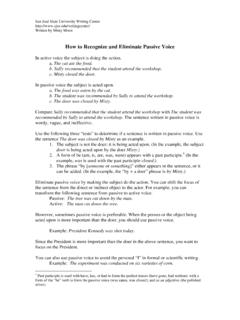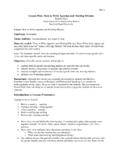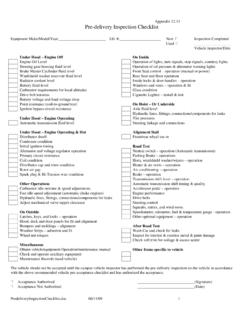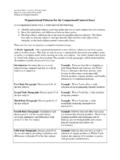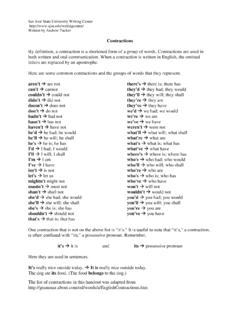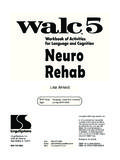Transcription of COGNITION Chapter 12: Problem Solving Cognitive …
1 COGNITIONC hapter 12: Problem SolvingCognitive Psychology (Reed)Summer 2014 Mark Van SelstSan Jose State UniversityCognitionVan Selst (Reed Chapter 12)Defining a problemThere is a Problem when a goal is not immediately able to be achieved ( , Reitman, 1965; Newell & Simon, 1972). Problem -solvingis the identification and selection of solutions to the SolvingDirected and Undirected Thinking Directed: Goal-oriented and rational Requires a clear well-defined goal Undirected: Meanders (day dreams, dreaming, drifting thoughts, etc.) Plays a role in creativity and poorly-defined problemsWell-Defined and Ill-Defined ProblemsVan Selst (Reed Chapter 12)Separating Problems by the skills needed to solve them (Greeno)Greeno (1978) proposes that problems be arranged into three types: (+ combinations) ARRANGEMENT (anagrams, Luchin swater jug).
2 Requires the Problem solver to organize the objects into a way that satisfies some criterion INDUCING STRUCTURE (reasoning by analogy) Requires the Problem -solver to rearrange objects in some way that forms a new relation among them TRANSFORMATIVE (tower of Hanoi; missionaries) Initial State, Goal State, Sequence of Operations (these define the Problem space)Arrangement Problems A Problem that requires rearranging its parts to satisfy a specified criterion , ANAGRAM: rearranging a string of letters to form a word or words (KEROJ ?; RWAET ?) Solving an arrangement Problem often involves a lot of trial and error during which partial solutions are formed and evaluated.
3 Dependent on: Fluency(generating possibilities), Retrieval of Solution Patterns, Knowledge of principles that constrain the search( , _JR_ unlikely)Van Selst (Reed Chapter 12)CognitionChessboard / Domino Problem (Mutilated Chessboard Problem )We have a chessboard with the two opposing corners removed, so that there are only 62 squares remaining. Now we take 31 dominoes shaped such that each domino covers exactly two squares. The question is: is it possible to arrange the 31 dominoes so that they cover all 62 squares on the chessboard?XXVan Selst (Reed Chapter 12)Inducing StructureCognitionTower Of Hanoi (Transformative / well-defined Problem )Well-Defined ProblemGoal State (clear)Initial State (clear)Subgoals( Problem can be broken down) Problem Space (all possible legal moves [operators])Move from start state to end state by moving one disk at a time, and never placing a smaller disk on a larger StateInitial StateVan Selst (Reed Chapter 12)CognitionProblem Space(Newell & Simon)
4 All possible legal movesEach legal move from the initial state to some intermediate state is specifically defined by an for x:Van Selst (Reed Chapter 12)CognitionTower Of Hanoi (the Problem space)Well-Defined Problem Goal State, Initial State, Subgoals, Problem Spaceall possible legal moves (operator actions) Goal StateVan Selst (Reed Chapter 12)CognitionMissionaries and Cannibals (transformative) Your task is to take 3 missionaries and 3 cannibals across the river. The boat holds 2. The cannibals must never outnumber the missionaries (or they will eat them).startfinishVan Selst (Reed Chapter 12)CognitionIll-Defined Problems How do you advance in your chosen career?
5 What is the goal state? What is your current state(initial state) What are the intermediate goals (subgoaldecomposition) What are all possible operations [OPERATORS]that could be employed ( , what is the Problem space?)Van Selst (Reed Chapter 12)CognitionWhere we are atWell-defined problems Your car doesn t start in the morning and you want to try and find out what s wrong with it You want to beat an opponent at chess You want to find a street in an unfamiliar cityIll-defined problems You want to be happy You want to be successful Draw a picture Write an essayVan Selst (Reed Chapter 12)CognitionProductive and Reproductive Problem SolvingThe GESTALT approach to Problem Solving differentiates between.
6 Productive Thinking insight and creativityReproductive Thinking following a sequence known to produce a workable answerVan Selst (Reed Chapter 12)CognitionGestalt approach to Problem -solvingAdapted their Problem - Solving approach from perception. Perception inherently involves restructuring. Two views of Necker cube seen by restructuring image to see as right or left Person often has to restructure a Problem in order to gain insight into its solutionVan Selst (Reed Chapter 12)CognitionInsightproblem Solving in monkeys: Kohler (1927) Monkeys showed insight during Problem - Solving .
7 Demonstrated productive new way of structuring elements showing insight and creativity Deep useful understanding of the nature of the Problem versus trial-and-error ( , reproductive// tried and true // rule-based) Problem Solving ( , of the cat-in-the-box of Thorndike, 1898).Solved problems by using stacks boxes to reach !Van Selst (Reed Chapter 12)CognitionGestalt approach to Problem -solvingTHE CANDLE Problem (Dunker, 1945) Fix lit candle to wall, with candle, box of nails & box of TWO-STRING Problem (Maier, 1931).Subjects in room with 2 strings hanging from ceiling and set of other objects (nut, bowl, pliers, sandwich.)
8 -Task is to attach the strings. However, cannot reach them at same Problem The subject is given a set of jugs of various stated capacities, and is asked to measure out a desired quantity of waterNINE-DOT Problem (Scheerer, 1931) Connect all nine dots by drawing four continuous lines?Van Selst (Reed Chapter 12)CognitionDuncker s(1945) Candle Problem (Functional Fixedness) Participants were provided a candle, a box of nails, and several other objects, and asked to attach the candle to the wall so that it did not drip onto the table below. Participants tried to nail the candle directly to the wall or to glue it to the wall by melting it.
9 Very few thought of using the inside of the nail box as a candle-holder and nailing this to the wall. The participants were fixated on the box s normal function of holding nails and could not reconceptualizeit in a manner that allowed them to solve the Selst (Reed Chapter 12)CognitionDuncker s(1945) Candle Problem (Functional Fixedness) Participants were provided a candle, a box of nails, and several other objects, and asked to attach the candle to the wall so that it did not drip onto the table below. Participants tried to nail the candle directly to the wall or to glue it to the wall by melting it.
10 Very few thought of using the inside of the nail box as a candle-holder and nailing this to the wall. The participants were fixated on the box s normal function of holding nails and could not reconceptualizeit in a manner that allowed them to solve the Selst (Reed Chapter 12)CognitionThe Two-String ProblemVan Selst (Reed Chapter 12)CognitionFunctional FixednessBirch and Rabinowitz(1951) adapted the two-cord Problem from Maier(1930, 1931), where subjects would be given 2 cords hanging from the ceiling, and 2 heavy objects in the room. They are told they must connect the cords, but they are just far enough apart that one cannot reach the other easily.

